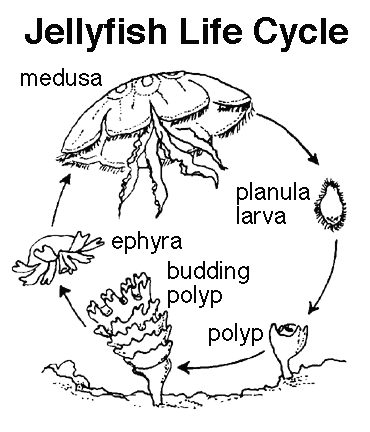Over kwallen
Onze verontschuldiging, maar deze tekst is alleen in de Engelse taal beschikbaar. Voor meer informatie neem contact met ons op op het adres: info@designjellyfish.com
A JELLIFISH AND ITS LIFE
What`s a jellyfish?
It is the second stage of their life cycle, which is typified as a free-swimming marine animal, consisting of a bell and trailing tentacles. They can be of different shapes – not just bell-like but also flat (slightly convex at the top and just a little concave at the bottom). Their top part is called an exumbrella and the bottom part subumbrella. Their mouths are placed at the bottom part of their bodies. Their digestive cavity consists of a tissue layer called gastrodermis, an outside tissue layer called epidermis and a gel-like region in the middle called mesoglea. They have sense organs on the edges of their bell and tentacles that serve mainly for moving and keeping their food.
The first stage of their life is a polyp. The body of polyps is usually cylindrical, lengthen along the axis of their body. They are usually small and colonial or they also live separately. They have one single body orifice and there is a relatively thin layer of gel-like tissue inside of their bodies. Their bottom part is attached to the substrate if they live separately or attached to other polyps if living in a colony. Their front part has a mouth and is surrounded by tentacles. Anthozoans only have one stage of their life – polyp. With Hydrooans, their two stages alternate. Scyphozoans` dominant stage is a jellyfish and they usually do not have a polyp stage.
Where do jellyfish live?
They live in seas all over the world, often in sea shores but there are some types that live in the depth of different seas. For example, the Stauromedusidaes live only in cold waters of the northern hemisphere. The Pelagia noctiluca, however lives only in warm waters. The jellyfish we see in aquariums such as the Aurelia aurita live mostly in European seas.
How does a life cycle of a jellyfish look?
Jellyfish have a stalked (polyp) phase when they are attached to coastal reefs, and a jellyfish (medusa) phase when they float among the plankton. The medusa is the reproductive stage; their eggs are fertilised internally and develop into free-swimming planula larvae. After a brief period floating about in surface waters, the larvae settle to the sea floor, attaching themselves at one end. There they develop into polyps and begin to feed and grow. In spring, some of the polyps start to bud off immature jellyfish known as ephyra larvae. These grow into mature jellyfish.
What are their bodies like?
Their body is in 97% water, usually it is bell-like and semi-transparent. Because their body is 95% water, which means they are perfectly camouflaged. The body of a jellyfish is divided into three main parts, the umbrella, the oral arms (around the mouth) and the stinging tentacles. They are animals with radial symmetry. They have an internal cavity, in which the digestion is carried out, denominated the gastro-vascular cavity and which has a single aperture which carries out the functions of both the mouth and the anus.
